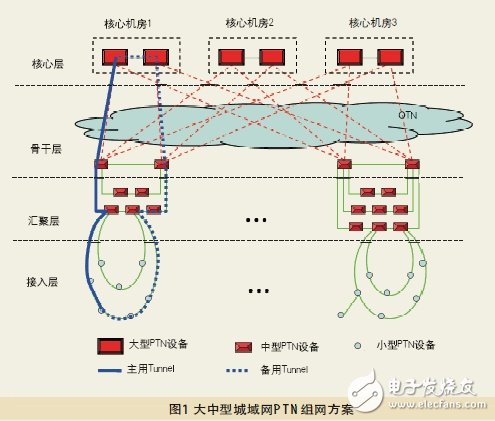After years of construction and optimization, China Mobile Metropolitan Area Transport Network based on SDH/MSTP technology has better met the transmission requirements of TDM-based voice services and a small number of data services, but the advent of 3G and full-service operations has enabled The IP-based data service becomes the main body of the metropolitan area network transmission. Although SDH/MSTP also has multi-service bearer capability, the TDM-based core makes it less efficient, more complex, and less flexible and scalable when carrying IP packet services, and packet-switched core-based transport technology PTN. After rapid development in recent years, it has gradually matured and is expected to become the next generation mainstream technology to replace SDH. Therefore, China Mobile launched a pilot project of IP transmission project in Hangzhou Mobile to test the feasibility of PTN networking.
1. Introduction to PTN
PTN is a transport network and technology for packet services. It is located at the aggregation access layer of the metropolitan area network, with packet switching as the core and multi-service support. It has the characteristics of flexible and statistical multiplexing transmission of data communication network. It also inherits the advantages of traditional optical transport network for connection, fast protection, and strong OAM capability.
PTN implements connection-oriented fast forwarding through label switching mechanism; end-to-end simulation of various non-packet services through PWE3 technology; end-to-end QoS control through DiffServ model; CIR (guaranteed bandwidth) and PIR (burst bandwidth) The mechanism implements statistical multiplexing; provides precise frequency and time synchronization through technologies such as synchronous Ethernet, IEEE 1588v2, and ToP; provides device protection, linear multiplex section protection, MPLS Tunnel APS, LAG, and FRR, and other rich protection modes and similar SDH Carrier-class OAM capabilities. The integration of multiple technologies has laid a good foundation for PTN to carry 3G base stations and full service with high efficiency and high quality.
PTN has two technical standards of MPLS-TP and PBT in its implementation, which are derived from the improvement of MPLS technology and Ethernet technology. The Huawei PTN series equipment used in the pilot of the Hangzhou Mobile IP transmission project uses MPLS-TP technology.
2. PTN networking and protection
PTN is a brand-new equipment standard. Its working mechanism and possible business models are very different from SDH. In order to give full play to the advantages of PTN, the new PTN is more suitable for 3G and full-service competition. Zhejiang Mobile organization experts from the province discussed the networking model and protection mode of PTN in detail, and developed a better networking and protection scheme based on the deployment of OTN.
In terms of the networking model, the bandwidth demand of each access point in the 3G era may increase by more than 10 times compared with the 2G era, causing the bandwidth pressure of the core layer and the backbone layer to rise sharply. If the 10 Gbit/s ring is configured in the same manner as the SDH/MSTP network, it is easy to expand the bandwidth of the core backbone ring. The expansion cost of the ring structure is high and the flexibility is poor. Therefore, the networking model of the core layer and the backbone layer has become the focus of PTN network structure optimization considerations. The final solution is to simplify the PTN structure with OTN's high-capacity service provision and carrier-class protection capabilities.

As shown in Figure 1, when the PTN device is deployed, the access layer and the aggregation layer are still in a ring structure. The access layer uses the GE rate, and the aggregation layer uses the ten-gigabit Ethernet rate ring. The structure of the two-node loop prevents the single node failure risk of the aggregation node and the backbone node. Instead of building a ring system at the backbone layer, each backbone layer node is directly connected to the relevant core layer node through a GE or a 10 Gigabit Ethernet link provided by the OTN. At the same time, two large PT N devices are configured in each core equipment room, which is responsible for the access of the service port of the equipment room and the scheduling of services, and implements security sharing.
In terms of protection, the SNCP protection of the SDH network is implemented by establishing an end-to-end MPLS tunnel protection. At the same time, in order to reduce the risk of simultaneous failure of the primary and backup tunnels caused by the end-to-end protection path being too long, the backbone layer is on the OTN. The link is then superimposed with a layer of channel protection. For a 3G RNC with a GE interface, the core layer PTN device introduces LAG protection when accessing the RNC interface to avoid a large number of service interruptions caused by single interface failure.
With Samsung Chips 100LM/W high light efficiency .
High brightness & high CRI CRI>80
Excellent thermal management t ensure long lifetime of LED
Suit for different kinds of indoor illumination lighting :such as shopping mall , super-market , hotel, restaurant ,ect
Strong spring to hold up the downlight
Dimmable Downlight,3W Dimmable Downlight,15W Dimmable Downlight,30W Dimmable Downlight
SHENZHEN KEHEI LIGHTING TECHNOLOGY CO.LTD , https://www.keheiled.com
